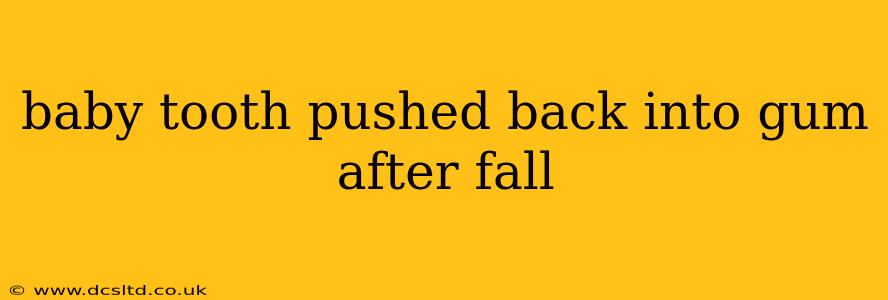A fall resulting in a baby tooth being pushed back into the gum is a frightening experience for both parent and child. This situation, known as a re-implantation injury, requires immediate and careful attention. This guide provides essential information on what to do, when to seek professional help, and what to expect during the recovery process. We'll address common concerns and answer frequently asked questions to ease your worries and ensure the best possible outcome for your child.
What to Do if a Baby Tooth is Pushed Back Into the Gum?
The first step is to stay calm. While this situation is undeniably concerning, panicked reactions can hinder effective first aid. Gently examine your child's mouth, checking for other injuries. Avoid touching the tooth itself.
Next, contact your dentist or pediatrician immediately. Time is crucial in these situations. Early intervention significantly improves the chances of a successful outcome. While waiting for your appointment, you can:
- Apply gentle pressure to control any bleeding using a clean gauze pad or cloth.
- Have your child rinse their mouth gently with warm, salt water to help clean the area.
- Avoid giving your child anything to eat or drink until after seeing the dentist.
- Monitor your child for any signs of infection, such as swelling, increased pain, or fever.
Do not attempt to reposition the tooth yourself. This could cause further damage to the tooth, gum, or surrounding tissues.
What Happens During a Dental Visit for a Re-implanted Baby Tooth?
Your dentist will conduct a thorough examination to assess the extent of the damage. They may take X-rays to check for root fractures or other injuries. Because baby teeth are eventually lost, the treatment approach often differs from that of permanent teeth.
In many cases, no intervention is necessary. The body will often reabsorb the displaced tooth naturally. The dentist will closely monitor the situation, checking for signs of infection or other complications. They may prescribe antibiotics if necessary.
In some instances, particularly if the tooth is significantly displaced or causing discomfort, the dentist may decide to remove the tooth. This is done to prevent complications.
Will the Baby Tooth Grow Back?
No, the baby tooth will not grow back. Baby teeth are temporary and are eventually replaced by permanent teeth. The focus of treatment is on managing any immediate problems, preventing infection, and ensuring the healthy development of the permanent tooth beneath.
What if the Tooth is Partially Visible?
If a portion of the tooth is still visible in the gum, avoid touching or manipulating it. Your dentist will assess the situation during your appointment and determine the best course of action. Often, leaving it alone is the recommended approach.
Is There a Risk of Infection?
Yes, there is a risk of infection. Careful monitoring and prompt dental attention are crucial in preventing infection. Your dentist may prescribe antibiotics to help minimize this risk. Observe your child for any signs of infection and contact your dentist immediately if any concerns arise.
My Child is in Significant Pain. What Should I Do?
Administer age-appropriate pain relief medication, such as acetaminophen or ibuprofen (always following the recommended dosage instructions). Contact your dentist or pediatrician immediately to report the pain and discuss potential treatment options.
How Long Will It Take to Heal?
Healing time varies depending on the extent of the injury. Most minor cases resolve without complications within a few days to a week. Your dentist will provide a more accurate prognosis based on your child's specific situation. Regular follow-up appointments may be necessary to monitor healing progress.
By following these guidelines and seeking prompt professional care, you can help ensure the best possible outcome for your child's re-implanted baby tooth. Remember, contacting your dentist is the most important step. Early intervention is key in managing this type of dental injury.
